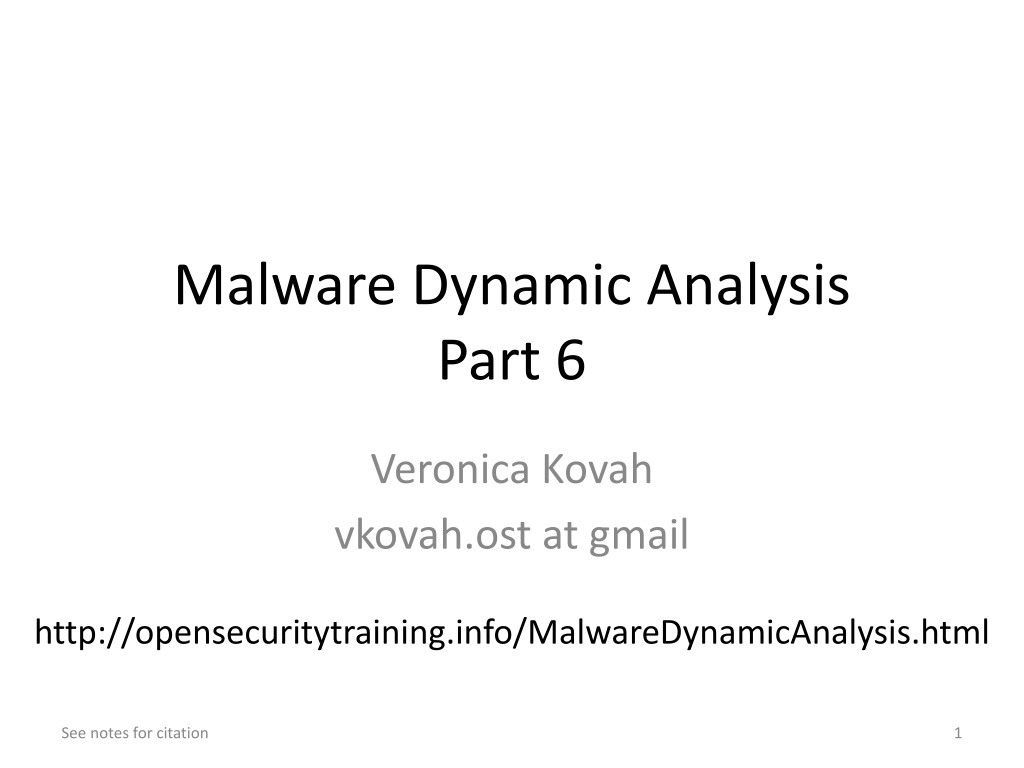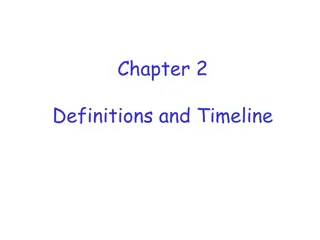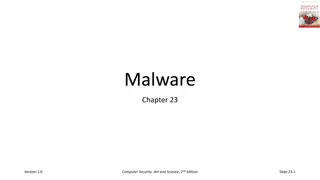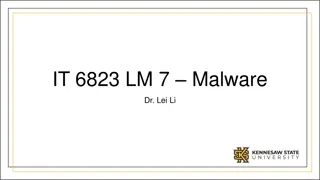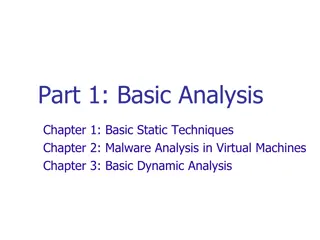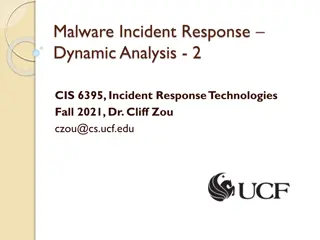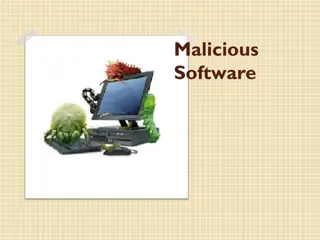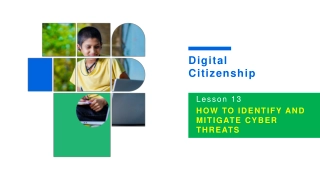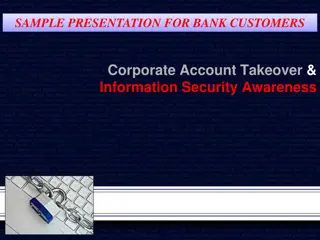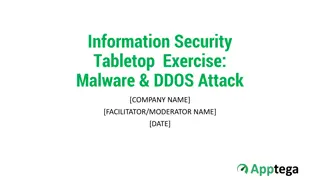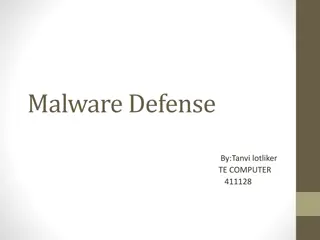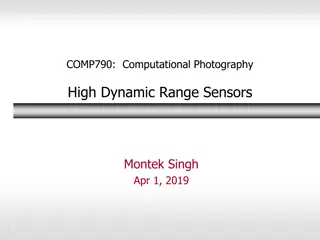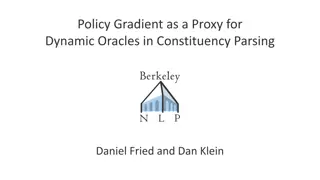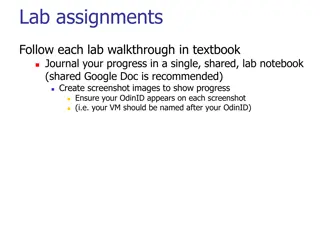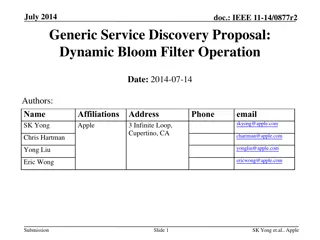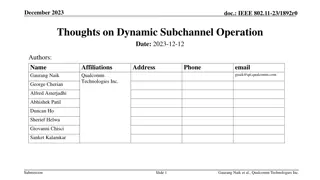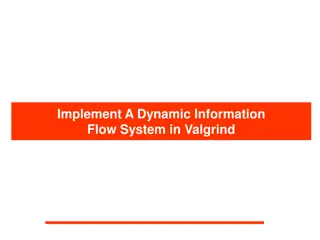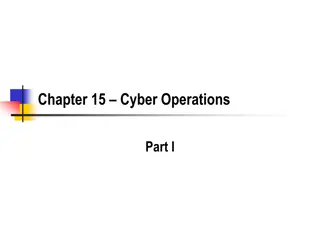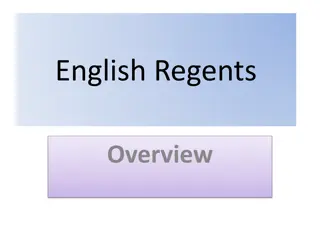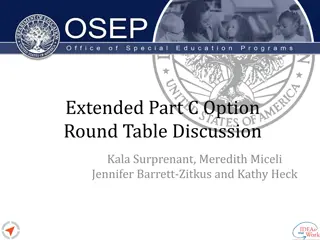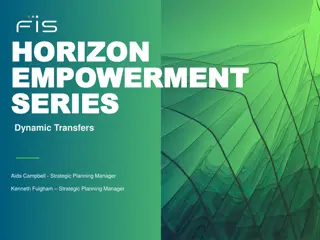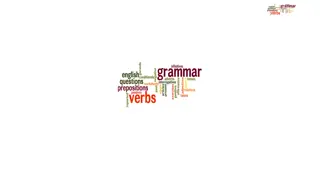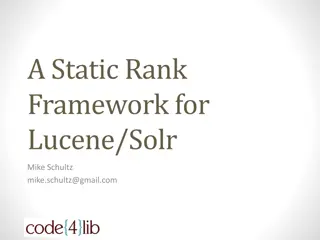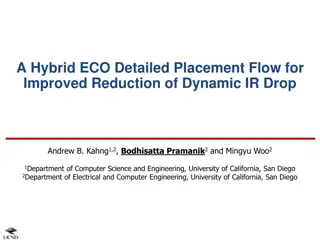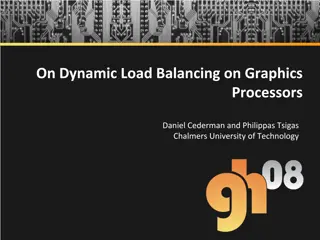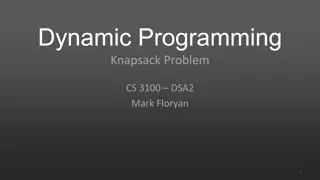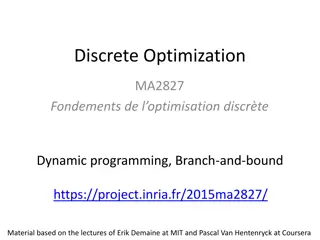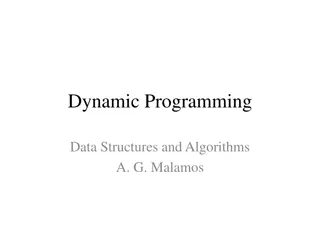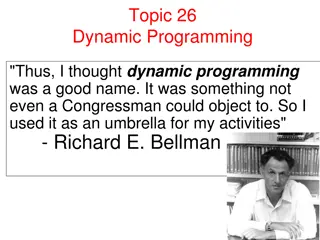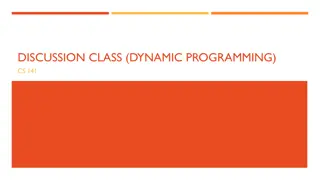Malware Dynamic Analysis Part 6 Overview
This content provides insights into Malware Dynamic Analysis Part 6 by Veronica Kovah. It covers actionable outputs like Yara and Snort, utilizing the open-source tool Yara to identify and classify malicious files based on patterns. The Yara signatures discussed include rules, identifiers, and condition operators. Valuable information for understanding malware analysis techniques and tools.
Uploaded on Sep 23, 2024 | 0 Views
Download Presentation

Please find below an Image/Link to download the presentation.
The content on the website is provided AS IS for your information and personal use only. It may not be sold, licensed, or shared on other websites without obtaining consent from the author. Download presentation by click this link. If you encounter any issues during the download, it is possible that the publisher has removed the file from their server.
E N D
Presentation Transcript
Malware Dynamic Analysis Part 6 Veronica Kovah vkovah.ost at gmail http://opensecuritytraining.info/MalwareDynamicAnalysis.html See notes for citation 1
All materials is licensed under a Creative Commons Share Alike license http://creativecommons.org/licenses/by-sa/3.0/ See notes for citation 2
Where are we at? Part 5: Using an all-in-one sandbox Cuckoo Sandbox Malware Attribute Enumeration and Characterization (MAEC) Different sandbox results comparison Part 6: Actionable output Yara Snort See notes for citation 3
Yara Open source tool to identify and classify malicious files based on textual or binary patterns Light-weight way of performing signature checks Can be used for any binary data (exe, pdf, pcaps, etc) Useful in an email server for tip-offs, and filtering See notes for citation 4
Yara Signature (1) rule silent_banker : banker { meta: description = "This is just an example" thread_level = 3 in_the_wild = true strings: $a = {6A 40 68 00 30 00 00 6A 14 8D 91} $b = {8D 4D B0 2B C1 83 C0 27 99 6A 4E 59 F7 F9} $c = "UVODFRYSIHLNWPEJXQZAKCBGMT" condition: $a or $b or $c } http://code.google.com/p/yara-project/ See notes for citation 5
Yara Signature (2) Identifier Any alphanumeric characters and underscores but cannot start with a number String definition A string identifier starts with $ followed by alphanumeric character and underscores Values Text strings enclosed by double quotes Hex strings enclosed by curly brackets Regular expression enclosed by slashes See notes for citation 6
Yara Signature (3) Condition operators Boolean and, or, not Relational >=, <=, <, >, ==, != Arithmetic +, -, *, / Bitwise &, |, <<, >>, ~ Counting strings strings: $a = text condition: #a == 6 See notes for citation 7
Bot classification We will make a Yara signature for a bot malware in this lab 1) Identify characteristic strings from the agobot sample $ strings ~/MalwareClass/samples/agobot/malware.exe > /tmp/agobot.txt 2) Make an Yara signature using combination of the identified strings Create a file (e.g. detection.yar) for the signature 3) Run Yara $ yara detection.yar ~/MalwareClass/samples/agobot/malware.exe See notes for citation 8
One possible answer rule Agobot { strings: $msg = "PhatBNC" nocase $conf1 = "ddos_maxthreads" $conf2 = "scan_maxsockets" $conf3 = "scan_maxthreads" $cmd1 = "do_stealth" $cmd2 = "do_avkill" $cmd3 = "do_speedtest" $cmd4 = "bot_topiccmd" $cmd5 = "bot_meltserver" $cmd6 = "bot_randnick" condition: (#msg > 10) and $conf1 and $conf2 and $conf3 and (any of ($cmd1, $cmd2, $cmd3, $cmd4, $cmd5, $cmd6)) } See notes for citation 9
Where are we at? Part 5: Using an all-in-one sandbox Cuckoo Sandbox Malware Attribute Enumeration and Characterization (MAEC) Different sandbox results comparison Part 6: Actionable output Yara Snort See notes for citation 10
Snort (1) Open source network intrusion detection/prevention tool (NIDS/NIPS) 3 modes Sniffer: read packets off the network and display on the screen Packet Logger: logs the packets to a log file NIDS: analyze network traffic and match with user-defined signatures and make actions (e.g. alert, drop, etc.) See notes for citation 11
Snort (2) Preprocessors provides various pre-detection processing Frag3: IP defragmentation Stream5: TCP/UDP session tracking RPC decode: RPC record defragmentation HTTP Inspect: HTTP fields identification, normalization etc. A preprocessor may depends on the other Supports custom preprocessor See notes for citation 12
Snort Signatures (1) Detection can be implemented in preprocessor, Snort (text) rules, or SO (shared object) rules. Snort rules DEST IP PORT SRC IP PORT alert tcp any any -> any 80 (msg: No deadbeef ; content: DEADBEEF ;) Rule headers Rule action tells Snort what to do (e.g. alert, log, drop) IP addresses in Classless Inter-Domain Routing (CIDR) notation Port numbers Direction operator should be -> or <> (bidirectional) See notes for citation 13
Snort Signatures (2) Rule options Separated by semicolon (;) msg: message to be displayed in log content: ascii string or binary to match content modifiers nocase, depth, offset, distance, within, http_header, http_client_body, http_uri, file_data pcre: match can be written in perl compatible regular expression flags: checks TCP flag bit sid: required field, Snort rule identifier See notes for citation 14
Detect Beaconing Traffic (1) We will write a NIDS signature for this lab on the host machine $ wireshark ~/MalwareClass/misc/darkshell.pcap & Lab is already configured Fixed the permission violation error $ sudo usermod -aG snort student Set HOME_NET to 192.168.57.0/24 in /etc/snort/snort.conf Let's run Snort with the existing Snort rules $ snort -c /etc/snort/snort.conf -r ~/MalwareClass/misc/darkshell.pcap -l /tmp See notes for citation 15
Detect Beaconing Traffic (2) Open a new file to write a Snort rule You can start with the following template and fill up detection rule options alert tcp any any -> any any ( <your rule options here> ) To test your rule $ snort -c <rule file path> -r <pcap file path> -l /tmp See notes for citation 16
Phone Home Format // Darkshell bot-to-CnC comms struct { // Header: DWORD dwMagic; // always 0x00000010 for Darkshell // Obfuscated section: char szComputerName[64]; // Name of infected host, NULL-terminated/extended char szMemory[32]; // Amount of memory in infected host; format "%dMB"; NULL- terminated/extended char szWindowsVersion[32]; // Specifies version of Windows; one of: Windows98, Windows95, // WindowsNT, Windows2000, WindowsXP, Windows2003, or Win Vista; // NULL-terminated/extended char szBotVersion[32]; // Specifies version of bot; NULL-terminated/extended; DWORD szUnknown1[4]; // ??? - Always NULL-terminated 'n' // Binary section: char szPadding1[32]; // Filled with 0x00 bytes WORD wUnknown2; // ??? - We have seen 0x00A0, 0x00B0, and 0x00C0 WORD wUnknown3; // ??? - Always 0xFD7F char szPadding2[20]; // Filled with 0x00 bytes WORD wUnknown4; // ??? - Always 0xB0FC BYTE cUnknown5; // ??? - We have seen 0xD6, 0xD7, 0xE6, 0xE7, and 0xF1 BYTE cZero; // Always 0x00 DWORD dwSignature[8]; // Always 0x00000000, 0xFFFFFFFF, 0x18EE907C, 0x008E917C, // 0xFFFFFFFF, 0xFA8D91&C, 0x25D6907C, 0xCFEA907C }; http://ddos.arbornetworks.com/2011/01/darkshell-a-ddos-bot-targetting-vendors-of-industrial- food-processing-equipment/ See notes for citation 17
What we learned in Part 1 How an isolated malware analysis lab is setup Ubuntu, Virtualbox, inetsim Malware terminology Bot, RAT, etc. Heterogeneous vendor naming RAT exploration - Poison IVY Implant and Controller Behavioral malware analysis approaches Diffing, monitoring, API tracing, etc. See notes for citation 18
What we learned in Part 2 Background concepts PE files, Windows Libraries, Processes, Registry, Windows Services TrID, Process Explorer, Process Monitor, PsService, CFF Explorer Persistence techniques Registry, File system, Windows services Autoruns, Regshot See notes for citation 19
What we learned in Part 3 Background concepts API, Threads Maneuvering techniques (How malware strategically positions itself to access critical resources) DLL and code injection, DLL search order hijacking, IAT, EAT, and inline hooking Procmon, WinApiOverride, Winobj See notes for citation 20
What we learned in Part 4 Background concepts How to analyze network traffic with Wireshark Malware functionality Key logging Phone home Beaconing Self-Avoidance Security degrading Simple stealth techniques (non-rootkit techniques) Self-destruction Hiding files See notes for citation 21
What we learned in Part 5/6 Using an all-in-one sandbox Good for automation and the first cut How to use Cuckoo Sandbox How to analyze sandboxes results Malware Attribute Enumeration and Characterization (MAEC) Actionable output detection signatures Snort: network intrusion detection/prevention system Yara: Malware identification and classification tool See notes for citation 22
All samples are from openmalware.org 101d00e77b48685bc02c1ff9672e1e94 eldorado/malware.exe 9250281b5a781edb9b683534f8916392 agobot/malware.exe 3349eab5cc4660bafa502f7565ff761d conficker/malware.exe 9f880ac607cbd7cdfffa609c5883c708 Hydraq/malware.exe a10b9b75e8c7db665cfd7947e93b999b parite/malware.exe d7578e550c0a4d4aca0cfd01ae19a331 spyeye/malware.exe df150905e2537db936ef323f48e2c1bb magania/malware.exe 4a29d41dfda9cfcbcde4d42b4bbb00aa Darkshell/malware.exe 1a36fb10f0a6474a9fea23ee4139d13e nitol/malware.exe db19c23c5f77a697500075c790cd331c IMworm/malware.exe a9a2fb545068995f30df22f8a3f22a10 onlinegames/2/malware.exe f1bae35d296930d2076b9d84ba0c95ea onlinegames/1/malware.exe See notes for citation 23
The End See notes for citation 25
